Timeline: The two Koreas
Key events in relations between North and South Korea since 1945.
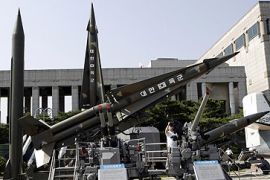
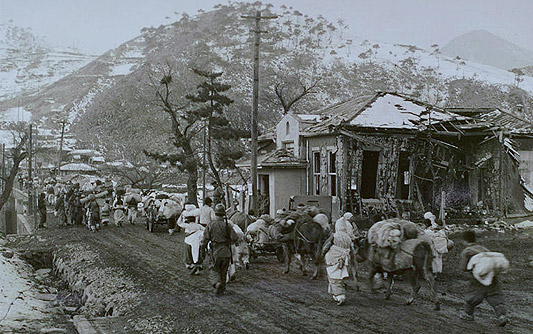 |
| The 1950-53 Korean War devastated the peninsula and left a bitter legacy [AP] |
1945
Second World War ends with Korean peninsula divided between a southern half, occupied by US troops, and a northern half occupied by Soviet troops.
1948
May 10 South Korea holds first elections without the involvement of the North, making Syngman Rhee the country’s first president and effectively sealing the division of the peninsula.
1950
June 25 North Korea, under Soviet-backed leader Kim Il-sung, invades the South, sparking three-year Korean War. About 10 million Koreans are separated from their families on either side of the border.
1953
July 27 Ceasefire signed at border village of Panmunjom. North and South Korea are formally divided at the 38th parallel.
1961
May 16 Military coup led by South Korean president Park Chung-hee deposes John Chang as prime minister, marking the start of a 26-year dictatorship.
1968
January 21 North Korean commandos attack the presidential palace – the Blue House – in Seoul, in an attempt to kill South Korean leader Park Chung-hee. Dozens are killed and wounded as South Korean forces hunt down the infiltrators.
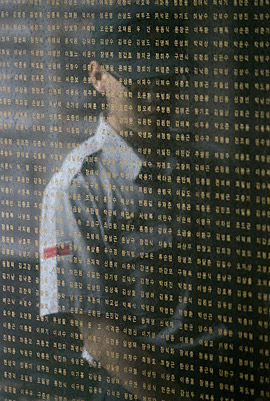 |
|
Millions were killed or wounded in the |
1972
Red Cross societies from both sides meet for the first time in Pyongyang to negotiate the reunion of Korean families separated since the end of the Korean War.
1974
August 15 Park Chung-hee escapes a second attempted assassination by a sole North Korean agent but a stray bullet kills his wife.
1979
October 26 Park is shot dead by his own intelligence chief Kim Jae-kyu during dinner at the agency’s headquarters following an argument with the president’s bodyguard.
1983
October 9 Bomb attack in Yangon, Myanmar, kills four members of South Korean government and narrowly misses Chun Doo-hwan, the South Korean president. The bomber later claims to have ties to North Korea, but Pyongyang denies involvement.
1984
Hints of a slight thaw in inter-Korean relations after North Korea offers food and material aid to a flood-stricken South.
1985
January Former South Korean president Chun Doo-hwan proposes an inter-Korean summit; four months later officials from both sides meet secretly in Bandung, Indonesia, for further discussions.
December 12 North Korea joins the Non-Proliferation of Nuclear Weapons treaty but refuses to sign a safeguards agreement with the International Atomic Energy Agency (IAEA), the UN nuclear watchdog, allowing international inspections of its nuclear facilities.
1987
November 9 Bomb destroys South Korean Boeing 707 airliner flying over the Andaman Sea, killing 260 passengers and crew. South Korea accuses Kim Jong-il, son of North Korea’s leader, of plotting the attack.
1991
September 17 North and South Korea join the United Nations.
December 13 The two nations sign a non-aggression agreement which includes replacing the Korean War armistice with a peace treaty, the absence of which has kept both sides technically at war.
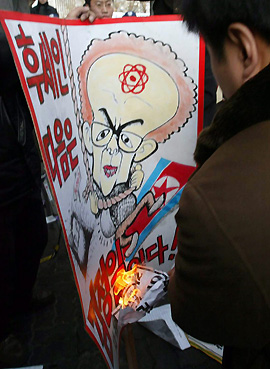 |
| North Korea’s nuclear test in 2006 sparked protests in the South [EPA] |
1992
January 20 North and South Korea sign the Joint Declaration on the Denuclearisation of the Korean Peninsula, stating that the two sides “shall not test, manufacture, produce, receive, possess, store, deploy or use nuclear weapons,” and that they “shall not possess nuclear reprocessing and uranium enrichment facilities.”
January 30 North Korea signs nuclear safeguards agreement with the IAEA.
1993
January North Korea refuses to allow IAEA special inspections of two unreported facilities suspected of holding nuclear waste, ignoring the terms of the Joint Declaration on the Denuclearisation of the Korean Peninsula.
March 12 North Korea announces it is pulling out of Nuclear Non-Proliferation Treaty.
1994
June Jimmy Carter, the former US president, visits North Korea and helps defuse tensions on the peninsula. Presidents of North and South Korea agree to hold first ever summit on July 25.
July 8 North Korean President Kim Il-sung dies. His son Kim Jong-il takes over leadership, derailing the planned summit.
1996
November 20 North Korea shuts down North-South Liaison Office in Panmunjom in the wake of heightened tensions.
1998
February 25 Kim Dae-jung sworn in as South Korea president, launches “sunshine policy” offering the North unconditional economic and humanitarian aid.
August 31 North Korea test-fires long-range Taepodong-1 missile over Japan; drawing criticism and prompting Japan to withdraw $1bn in aid meant for two civilian nuclear reactors.
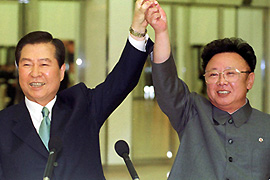 |
| The landmark 2000 inter-Korean summit was a high point for relations [AP] |
2000
June 13-15 Landmark inter-Korean summit takes place in Pyongyang. Kim Jong-il and Kim Dae-jung sign joint declaration to work toward reunification.
August 14 North-South Liaison Office reopens at truce village Panmunjon in the demilitarised zone.
August 15 100 members of separated families head to Pyongyang and Seoul for first-ever family reunion since the Korean War.
September 15 North and South Korean teams march together at the Sydney Olympics under a single flag held by two athletes.
November 30 Second reunion of 100 Korean family members in the Korean capitals.
2002
June 29 North and South Korean navies clash over a disputed sea border which Pyongyang declared as invalid in 1999. Five South Koreans are killed and more than a dozen wounded.
October 16 US accuses North Korea or operating a programme to enrich uranium for nuclear weapons, prompting an international stand-off.
2003
January 10 North Korea withdraws from the Non-Proliferation Treaty, which marked the beginning of a series of six-party talks involving China, the Koreas, US, Japan and Russia.
August 27 First round of six-party talks held in Beijing.
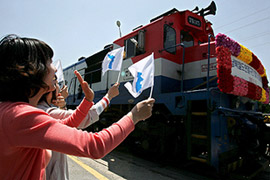 |
|
In 2007 trains from both sides crossed the DMZ for the first time in more than 50 years [EPA] |
2006
July 5 North Korea test-fires seven missiles including a long-range Taepodong-2 as part of “regular military drills to strengthen self-defence”. The move caused an international furore.
October 9 North Korea conducts its first nuclear test a day after Kim Jong-il’s 10th anniversary in power.
2007
February 13 North Korea agrees to close its main nuclear reactor in exchange for fuel aid as part of deal reached during six-nation talks in Beijing.
May 17 First trains in more than 50 years cross the four-kilometre demilitarised zone at the inter-Korean border.
May North Korea test-fires short-range missiles into the Sea of Japan, sparking alarm across the region and worldwide criticism.
July 12 South Korea sends first shipment of 50 million tonnes of fuel oil to North Korea as part of aid-for-disarmament deal.
July 16 International inspectors confirm North Korea has shut down Yongbyon nuclear plant, its sole plutonium-producing reactor.
July 26 Senior military leaders from both sides hold three-day dialogue which ends badly after North Korean generals storm out of talks.
August 8 North and South Koreas announce plans for the second inter-Korean summit.
August 24 South Korea announces it will send nearly $50m in aid to the North after Pyongyang makes rare appeal for international aid following devastating floods.
September 2 US says North Korea agrees to declare and disable all nuclear facilities by end of 2007.
October 2 South Korean president Roh Moo-hyun crosses border into North Korea for second inter-Korean summit in Pyongyang.
December 31 A deadline passes for North Korea to present a detailed report of its nuclear programmes. The US says North Korea must provide a full and accurate declaration of all programmes, but Pyongyang later argues it has already provided one.
2008
February 25 Lee Myung-bak takes office as South Korean president. He promises to take a harder line on the North than his more liberal predecessors and says he will not shy away from criticising North Korea‘s human rights abuses. In the following weeks relations take a marked turn for the worse.
February 26 The New York Philharmonic plays an historic concert in Pyongyang seen as a major step in opening cultural ties between North Korea and the US.
March 27 South Korea‘s new chairman of the Joint Chiefs of Staff, General Kim Tae-Young, tells parliament the South will launch a pre-emptive strike against the North’s nuclear sites if it suspects an attack with nuclear weapons is imminent.
March 28 Pyongyang expels South Korean officials working at the joint Kaesong industrial park in the North, one of the few examples of North-South cooperation.
March 29 North Korea test fires short-range missiles into the sea.
March 31 North Korea threatens to turn the South into “ashes”.
April 1 North Korean media accuses South Korea‘s president, of being a US stooge and causing instability on peninsula.